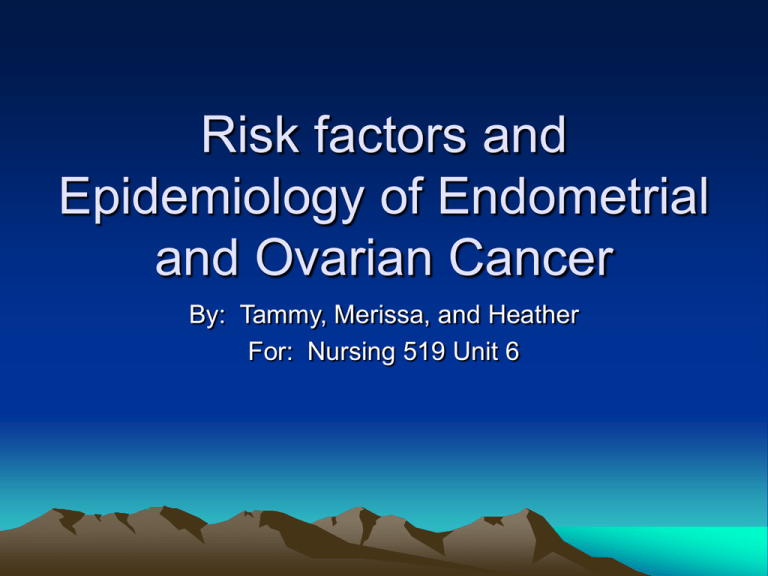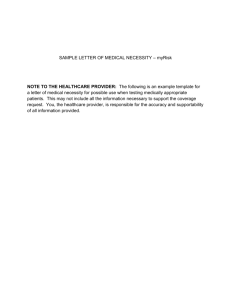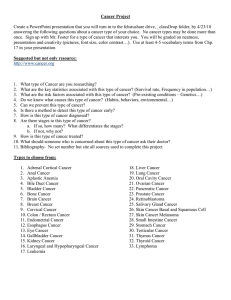Risk factors and Epidemiology of Endometrial and Ovarian Cancer
advertisement

Risk factors and Epidemiology of Endometrial and Ovarian Cancer By: Tammy, Merissa, and Heather For: Nursing 519 Unit 6 • Endometrial cancer and ovarian cancer share many risk factors, however there are a few differences. Endometrial Cancer - Epidemiology • Endometrial cancer is the most common cancer of the pelvic region and accounts of 6% of all cancers in women (McCance & Huether, 2006). • There is a higher incidence in white women, but higher mortality rates (nearly double) in black women (McCance & Huether, 2006). Risk Factors for Endometrial Cancer • Chronic exposure to estrogen, which can be caused by… • Early menarche (beginning menstruation before age 12) • Hormone replacement therapy (HRT) with exogenous estrogen (i.e., without progesterone) • Late menopause (after age 52) Risk factors for Endometrial Cancer • Presence of an estrogen-secreting (tumour (e.g., some types of breast cancer) • Nulliparity (having never given birth) or low parity (Swierzewski, 1999) • Women with hereditary nonpolyposis colorectal cancer, caused by a genetic abnormality, have an increased risk of developing a variety of cancers, including endometrial cancer (Mayoclinic, 2008). Risk factors for Endometrial Cancer • Age (more common after age 50) • Family history of uterine cancer • Personal history of breast, colorectal, or ovarian cancer • Prior pelvic radiation therapy • Race (endometrial cancer is more common in Caucasian women and uterine sarcoma is more common in African American women) • Obesity (Swierzewski, 1999). Protection against Endometrial Cancer • The birth control pill, controlling obesity, managing hypertension, and controlling diabetes have proven to have protective benefits against endometrial cancer (Copstead & Banasik, 2000; Mayoclinic.com, 2008; McCance & Huether, 2006). Challenges in detecting Endometrial Cancer • Endometrial cancer can be difficult to detect as it is largely asymptomatic, however vaginal bleeding is a common sign. This can be misleading as the majority of the population of women with endometrial cancer are in the menopausal age group and may consider this a normal sign to completing menarche. Ovarian Cancer - Epidemiology • Ovarian cancer accounts for 3% of all cancers in women and has the greatest mortality rate (66%) of all female reproductive cancers, likely due to being difficult to detect in the early stages of the disease (Copstead & Banasik, 2000; McCance & Huether, 2006). • Ovarian cancer has a 5-10% familial inheritance, often associated with the breast cancer gene 1 or 2 (McCance & Huether, 2006). Risk factors for Ovarian Cancer • Family History (mother or sister with the disease, usually developed early) • Age (over 55) • Obesity • Never pregnant • Hormonal therapy (MedicineNet.com, 2009). Risk Factors for Ovarian Cancer • Early menarche • Late menopause • Use of fertility drugs (McCance & Huether, 2006) Protection against Ovarian Cancer • Factors providing protective benefits against ovarian cancer include multiple pregnancies, prolonged lactation, and use of birth control pills (Mayoclinic.com, 2008; McCance & Huether, 2006). To Recap… • Common risk factors for Endometrial and Ovarian Cancers… • Early menarche • Late menopause • Familial (genetic) predisposition to cancer • Obesity (McCance & Huether, 2006; Mayoclinic, 2008; MedicineNet.com, 2009; Swierzewski, 1999). To Recap… • Common protective factors against Endometrial and Ovarian Cancers… • Oral contraceptive (birth control pill) use • Controlling obesity • Having babies! (McCance & Huether, 2006) A question to ponder... • As a NP, what test(s) would you order if you suspected a patient had endometrial cancer? Ovarian cancer? • Thank you for your participation! References: • Copstead, L. C., & Banasik, J. (2000). Pathophysiology: Biological and behavioral perspectives. (2nd ed.). Philadelphia, PA: W.B. Saunders Company. • Mayoclinic.com (2008). Endometrial cancer. Retrieved February 9, 2009 from http://www.mayoclinic.com/health/endometrialcancer/DS00306/DSECTION=risk%2Dfactors • Mayoclinic.com (2008). Ovarian cancer. Retrieved February 9, 2009 from • http://www.mayoclinic.com/health/ovariancancer/DS00293/DSECTION=risk%2Dfactors References: • McCance, K., & Huether, S. (2006). Pathophysiology: The biologic basis for disease in adults and children. (5th ed.). St. Louis, MI: Elsevier Mosby. • MedicineNet.com. (2009). Ovarian Cancer. Retrieved February 9, 2009 from: http://www.medicinenet.com/ovarian_cancer/pag e2.htm • Swierzewski, S. (1999). Endometrial Cancer: Causes and risk factors, signs and symptoms. Retrieved February 9, 2009 from: http://www.oncologychannel.com/endometrialca ncer/riskfactors.shtml





